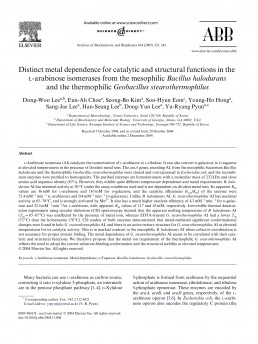Click the link above for more details.
Distinct metal dependence for catalytic and structural functions in the L-arabinose isomerases from the mesophilic Bacillus halodurans and the thermophilic Geobacillus stearothermophilus
Abstract
L-Arabinose isomerase (AI) catalyzes the isomerization of L-arabinose to L-ribulose. It can also convert D-galactose to D-tagatose at elevated temperatures in the presence of divalent metal ions. The araA genes, encoding AI, from the mesophilic bacterium Bacillus halodurans and the thermophilic Geobacillus stearothermophilus were cloned and overexpressed in Escherichia coli, and the recombinant enzymes were puriWed to homogeneity. The puriWed enzymes are homotetramers with a molecular mass of 232 kDa and close amino acid sequence identity (67%). However, they exhibit quite diVerent temperature dependence and metal requirements. B. halodurans AI has maximal activity at 50 °C under the assay conditions used and is not dependent on divalent metal ions. Its apparent Km values are 36mM for L-arabinose and 167mM for D-galactose, and the catalytic eYciencies (kcat/Km) of the enzyme were 51.4mM¡1 min¡1 (L-arabinose) and 0.4mM¡1 min¡1 (D-galactose). Unlike B. halodurans AI, G. stearothermophilus AI has maximal activity at 65–70 °C, and is strongly activated by Mn2+. It also has a much higher catalytic eYciency of 4.3mM¡1 min¡1 for D-galactose and 32.5mM¡1 min¡1for L-arabinose, with apparent Km values of 117 and 63 mM, respectively. Irreversible thermal denaturation experiments using circular dichroism (CD) spectroscopy showed that the apparent melting temperature of B. halodurans AI (TmD65–67 °C) was unaVected by the presence of metal ions, whereas EDTA-treated G. stearothermophilus AI had a lower Tm (72 °C) than the holoenzyme (78 °C). CD studies of both enzymes demonstrated that metal-mediated signiWcant conformational changes were found in holo G. stearothermophilus AI, and there is an active tertiary structure for G. stearothermophilus AI at elevated temperatures for its catalytic activity. This is in marked contrast to the mesophilic B. halodurans AI where cofactor coordination is not necessary for proper protein folding. The metal dependence of G. stearothermophilus AI seems to be correlated with their catalytic and structural functions. We therefore propose that the metal ion requirement of the thermophilic G. stearothermophilus AI reflects the need to adopt the correct substrate-binding conformation and the structural stability at elevated temperatures.
CategoryPeer-reviewed PublicationsDate2004.12Linkwww.ncbi.nlm.nih.gov
